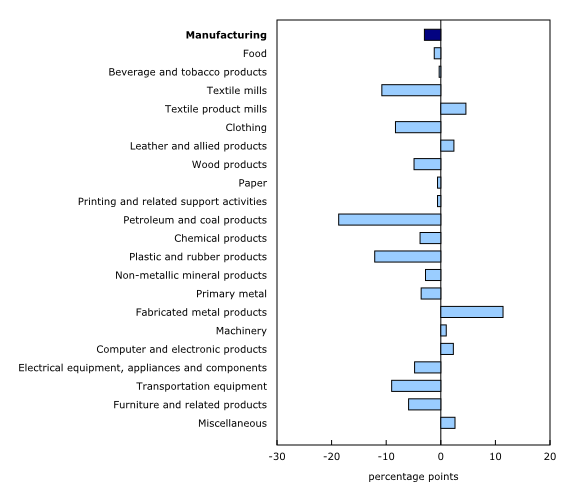Industrial capacity utilization rates, fourth quarter 2018
Archived Content
Information identified as archived is provided for reference, research or recordkeeping purposes. It is not subject to the Government of Canada Web Standards and has not been altered or updated since it was archived. Please "contact us" to request a format other than those available.
Released: 2019-03-08
81.7%
Fourth quarter 2018
-1.1 pts 
(quarterly change)
Canadian industries operated at 81.7% of their production capacity in the fourth quarter, down from 82.8% in the third quarter. This was the second consecutive quarterly decline.
The manufacturing and construction sectors were the main sources of this decline. Lower capacity utilization in manufacturing, construction, mining and quarrying, and forestry and logging more than offset increases in electric power generation, transmission and distribution, and oil and gas extraction.
Lower capacity utilization in the manufacturing sector
The manufacturing capacity utilization rate decreased 1.6 percentage points to 78.5% in the fourth quarter. Year over year, the rate declined by 3.0 percentage points, coinciding with lower output.
Year over year, capacity utilization decreased in 15 of the 21 major manufacturing groups, accounting for approximately 80% of the manufacturing sector's gross domestic product.
The decrease in capacity utilization among petroleum and coal product manufacturers followed a strong increase in the previous quarter. The capacity utilization rate in this industry decreased by 16.1 percentage points to 72.7% in the fourth quarter. This represented a year-over-year decrease of 18.7 percentage points. This decline was mostly due to lower production following refurbishment and maintenance work carried out at certain refineries.
Among plastic and rubber product manufacturers, the capacity utilization rate fell 12.1 percentage points year over year to 71.7% in the fourth quarter. This decline was due to lower production, stemming from fewer orders and seasonal shutdowns of certain facilities.
The overall decrease in the manufacturing sector was partially offset by increases in the fabricated metal products manufacturing industry, which rose for the fourth consecutive quarter. The increase coincided with high prices for fabricated metal products and building supplies. Year over year, the utilization rate for this industry rose 11.4 percentage points to 77.0% in the fourth quarter.
Capacity utilization in the construction sector continues to decline
After declining 2.1 percentage points in the third quarter, capacity utilization in the construction sector was down a further 2.2 percentage points to 85.4% in the fourth quarter, compared with 89.6% in the fourth quarter of 2017. The decrease was attributable to lower activity in most construction subsectors.
Capacity utilization in mining and quarrying, excluding oil and gas extraction was down 1.1 percentage points to 76.9% in the fourth quarter. The decline followed a 2.2 percentage point increase in the previous quarter and was due in part to lower activity in support activities for mining and oil and gas extraction.
Conversely, capacity utilization in electric power generation, transmission and distribution increased 1.9 percentage points to 86.6%. It was the second consecutive quarterly gain as colder temperatures in most of Canada increased electricity demand for heating purposes.
The capacity utilization rate in oil and gas extraction edged up to 84.5% in the fourth quarter, following the increase in oil and gas extraction, excluding oil sands.
Annual average capacity utilization rises in 2018
The average capacity utilization rate of Canadian industries rose 1.2 percentage points to 82.8% in 2018, after increasing 2.4 percentage points in 2017. The rise was mainly attributable to the rebound in the oil and gas extraction subsector in the first half of the year.
In 2018, the annual average capacity utilization rate increased in mining, quarrying and oil and gas extraction as well as in construction, but decreased in forestry and logging, and electric power generation, transmission and distribution.
The annual average capacity utilization rate of all manufacturing industries edged down to 80.1% in 2018, after decreasing 1.4 percentage points in 2017. The capacity utilization rate was down in 12 of the 21 major manufacturing groups.
Note to readers
The industrial capacity utilization rate is the ratio of an industry's actual output to its estimated potential output.
This program covers all manufacturing industries, as well as forestry and logging, mining, quarrying and oil and gas extraction, electric power generation, transmission and distribution, and construction industries.
With this release of the industrial capacity utilization rates, the data have been revised back to the first quarter of 2018 to reflect the latest revisions to the source data.
Next release
Data on industrial capacity utilization rates for the first quarter will be released on June 7.
Products
The Latest Developments in the Canadian Economic Accounts (13-605-X) is available.
The User Guide: Canadian System of Macroeconomic Accounts (13-606-G) is available.
The Methodological Guide: Canadian System of Macroeconomic Accounts (13-607-X) is available.
Contact information
For more information, or to enquire about the concepts, methods or data quality of this release, contact us (toll-free 1-800-263-1136; 514-283-8300; STATCAN.infostats-infostats.STATCAN@canada.ca) or Media Relations (613-951-4636; STATCAN.mediahotline-ligneinfomedias.STATCAN@canada.ca).
- Date modified:


